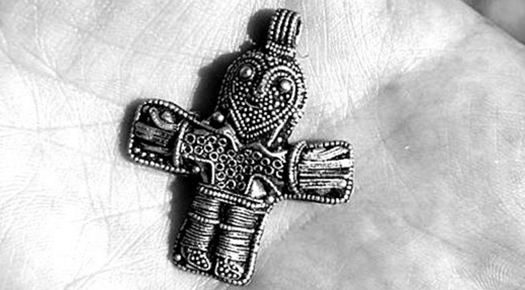
A 1,100-year-old crucifix that dates back to the first half of the 10th century could potentially change history, believes the archaeologist who found it. The small pendant was discovered last month by Dennis Fabricius Holm in the Danish town of Anslev Ostfyn.
On a Facebook post, Holm explained that the day he got off work early, he decided to explore Anslev with his metal detector. That is when he reportedly stumbled upon the crucifix, which is small enough to fit in the palm of his hand. The crucifix, which has an intricate design of gold wiring and beading, was in all likelihood worn by a Viking woman who converted to Christianity, say historians.
“I've hardly slept!” Holm said of his discovery, adding that the experience “has been very overwhelming. I have not yet grasped that find's influence on Denmark's history. It is hard to comprehend.”
According to archaeologists, this tiny discovery could alter the history of the religion in the region, as it dates back at least 15 years earlier than what the previously oldest-known artifact indicated as the beginning of Christianity in Denmark. It is largely accepted that by the year 965, Vikings had started to renounce their faith in pagan gods –like Thor and Oden– and turn towards Christianity. Another crucifix, almost identical to this one and dating back to the same period, was earlier discovered in Sweden. Together, the two crucifixes indicate a more rapid acceptance of Christianity than previously thought.
The most ancient Christian symbol to be discovered in Denmark is a pair of large carved stones in the city of Jelling. While only one of the rocks depicts Jesus Christ, they both date back to the 10th century. According to historians, these ancient rune stones marked the conversion of King Harold Bluetooth Gormmson and his Viking subjects to Christianity. Gormmson is believed to have died in 986.
“In recent years there has been more and more signs that Christianity was widespread earlier than previously thought —and here the clearest evidence so far,” said Malene Refshauge Beck, curator and archaeologist at Østfyn's museum.
Describing the crucifix as an absolute sensational discovery, Beck explained how Christian missionaries like Willerich, Willbrord and Ebbo worked among Vikings from the start of the 8th century. Most Vikings are believed to have converted to Christianity by the end of the Viking era, which is believed to have perished by 1066.
“The figure can, therefore, help to advance the time when one considers that the Danes really were Christians,” Beck said. “Simply because one can say that the person who carried it here no doubt embraced the Christian faith.”
Photo Credits: History Heretic
